ISSN ONLINE(2319-8753)PRINT(2347-6710)
ISSN ONLINE(2319-8753)PRINT(2347-6710)
Manju G 1
|
| Related article at Pubmed, Scholar Google |
Visit for more related articles at International Journal of Innovative Research in Science, Engineering and Technology
While during building construction, the frame structures are constructing first due to ease of construction and later the frames are infilled by masonry brick infill or concrete blocks or finished stones or concrete hallow blocks. The infill walls are giving protection from outside environment like external walls and also divide the inside structure like as partition walls. Predicting the behaviour of infill while during seismic action is difficult because it is brittle and ductility in nature. The IS code provisions do not provide any guidelines for the analysis and design of RC frames with infill wall, so during the analysis infilled frame is considered as bare frame and neglecting effect of infill on frame. In this study, we carried a effect of infills on bare frame, masonry infill and soft storey models. The vertical discontinuity of stiffness in the structure called as soft storey. The soft storey are considering in different floors for different models like at ground floor, first floor, second floor, third floor and last floor. All the models are analysed by response spectrum analysis and infills are modelled by equivalent diagonal strut. Following parameters are determining like time period, displacement, storey shear, column forces and axial forces in columns
Keywords |
| Bare Frame (BF), Masonry Infill without Soft Storey (MI), Masonry Infill with Soft Storey (SS), Equivalent Diagonal Strut |
INTRODUCTION |
| In multi-storey buildings, the RC frame structures are constructed initially due to ease of construction and rapid work in progress. The masonry infilled RC frame buildings are commonly constructed for commercial, residential and industrial buildings in seismic regions. Infilled frames are composite structures formed by the combination of moment resisting plane frame and infill wall. The infills are mostly used as interior partition walls and external walls which are protecting from outside environment to the building according to the requirements. The failure or collapse of buildings during earthquake is due to geological effects, poor form, inadequate design and detailing and poor quality of construction. |
| The infill increases strength and stiffness to the structure. While during analysis, not considered the effect of infill due to lack of knowledge between infill and frame. Proper consideration of stiffening effect of infill on the frame is often important as it can considerably alter the behaviour of building in elastic range. Infill reduces the lateral deflection of the building, displacement, bending moments in frame and increasing axial forces in columns this leads to decreasing of probability of collapse. |
| Equivalent Diagonal Strut: The first research is carried out on infilled RC frame subjected to lateral load by polyakov [9]. Infill walls are analytically replaced by equivalent diagonal struts [3]. Considering single diagonal strut for modelling infill and it carries only compression forces. The end points of the strut connected to the frame is pin jointed to avoid the moment from frame to infill. Chethan.K [14] proposed an empirical relation of single equivalent diagonal strut width for modelling infill and it is based on smith and carter [13]. |
| ïÃâ÷ Chethan.K(2009) |
| W = 1.414ïÿýïÿýïÿýïÿý ... (1) |
 |
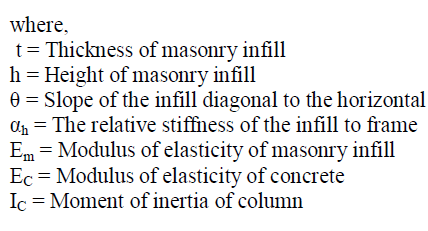 |
II. MATERIALS AND METHODS |
| In this study, consider seven different models of BF, MI and SS. The infills are modelled by macro model, which is that they try to encompass the overall behaviour of a structural element without modelling all the possible modes of local failure. The total plan dimension is (25X20)m is having five bays in both X and Y axis respectively and storey height of 3.5m in each storey. Analysis is carried out by response spectrum method by ETABS V9.7 software. Material concrete grade M30, steel Fe 415 is and brick infill are used. The unit weight of masonry is 20kN/m3 and unit weight of concrete is 25kN/m3. The young’s modulus and poisson’s ratio of concrete is 27386mpa and 0.2 respectively. Young’s modulus and poisson’s ratio of masonry is 5500mpa and 0.15 respectively. The floor finish is 1.5kN/m2 and live load is 3.5kN/m2. Thickness of slab and infill wall is 150mm and 230mm respectively [2]. According to IS1893 (part 1): 2002 clause 7.3.1[16] the live load multipled by 50%. The cross section of column is (0.23X0.6)m [15], beam is (0.23X0.45)m [15] and modal damping is 5%. The building is located on medium soil in seismic zone IV with response reduction factor of 5. |
III. LITERATURE SURVEY |
| The infills have initial lateral stiffness and low deformability. The structural contribution of infill cannot simply be neglected particularly in regions of moderate and high seismicity where, the frame-infill interaction may cause substantial increase in both stiffness and strength of the frame inspite of presence of openings. The modelling of infill is given by two methods: macro model (equivalent diagonal strut) and micro model (finite element model). The macro modelling is based on physical understanding of the behaviour of each infill panel as a whole. |
| The micro modellings are often used to conduct detailed analytical studies of behaviour of frames with infill. The first published research on infilled R.C frames subjected to lateral load was given by Polyakov [9]. Holmes [3] proposed the equivalent diagonal strut for modelling infill wall and the diagonal struts are pin-jointed at it ends. Smith [13] proposed the theoretical relation for width of diagonal strut based on relative stiffness of R.C frame. Mainstone [4] and Saneinejad [10] studied on steel frames with brick infill. P.G. Asteris [8] considered finite element modelling of infill with some percentage of openings in infill. |
IV. OBJECTIVES |
| A comparative study is carried out on 3D RC frame structures of seven different models of BF, MI and SS to know the effects of infills on buildings in seismic regions. Infills are modelled by single strut method and response spectrum analysis is carried out to find the lateral stiffness of the structure. Out of seven models differentiate as one BF, one MI and five SS models. Consider G+9 storey building for the analysis with and without infill. Following parameters are discussed like time period, displacement, storey shear, column forces and axial forces in column. |
V. METHODOLOGY |
| The plan layout of the RC frame building is with infill, without infill and soft storey located at different floors like ground floor, first floor, second floor, third floor and last floor are chosen for this study as shown in Fig.1. The building is kept symmetric in plan to avoid torsional response under lateral forces. |
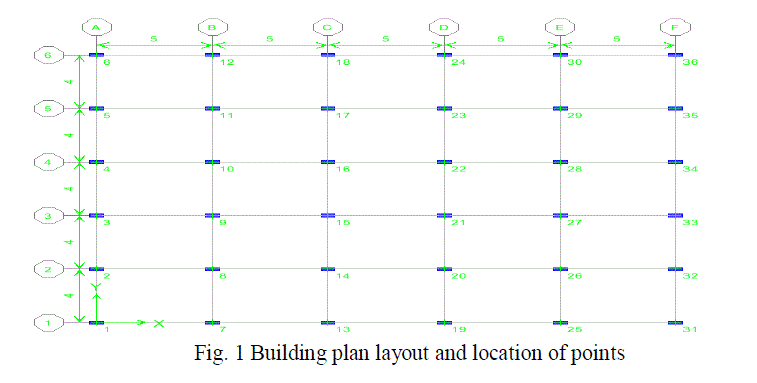 |
| Diagonal strut and Model details – The infills are modelled by single equivalent diagonal strut approach and its thickness is equal to infill wall thickness. The ends of strut are pin connected to frame and make it moment releases at it ends, to avoid the transfer of moment from frame to strut. Considering chethan.k[14] diagonal strut width expressions for modelling the infill and it is based on smith and carter[13]. |
 |
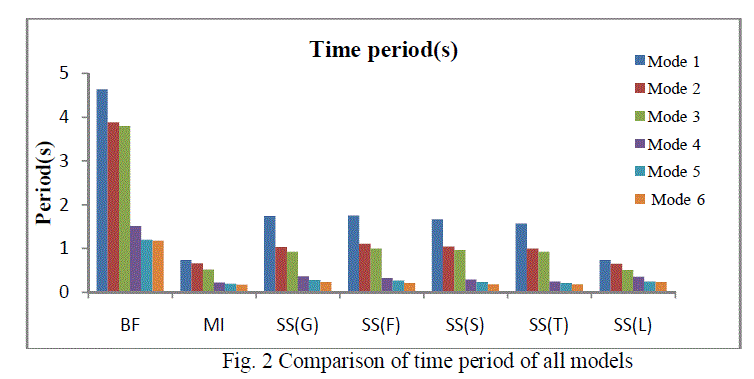 |
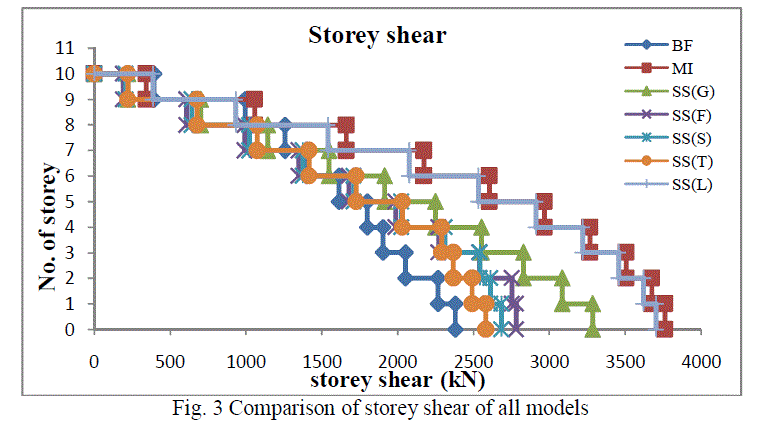 |
VI. RESULTS AND DISCUSSIONS |
| This paper work is carried out to compare the dynamic response of RC bare frame, masonry infill and soft storey. Totally seven models are considered for the dynamic analysis which includes modal analysis and response spectrum analysis. |
1. Time Period |
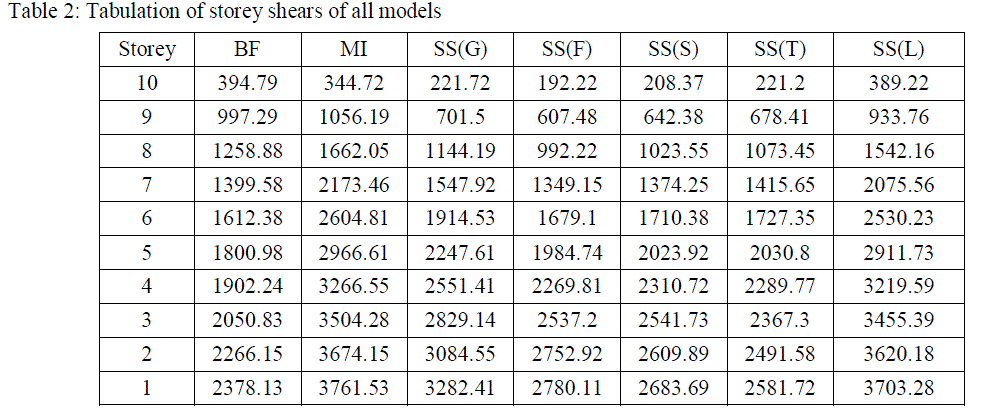 |
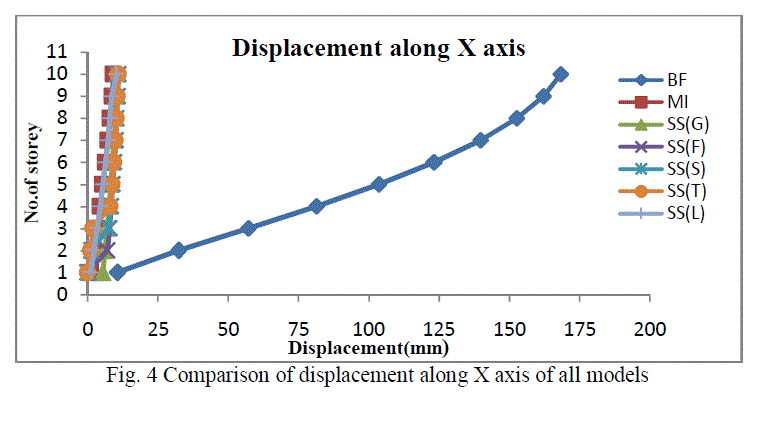 |
| Introduction of infill wall in the RC frame reduces the time period of BF and enhances stiffness to the structure. The time period is more in BF than MI and SS models. In SS models, time period is depending on location of soft storey providing. In the SS models, period is maximum in SS(G) and SS(F) and it depends on providing soft storey at respective floors as shown in Fig.2. The time period of the structure is depends on the mass and the stiffness characteristics of the structure. The presence of infill in MI and SS models, the stiffness increases with decreasing in time period. Time period is increases with decrease in natural frequency. |
2. Storey Shear |
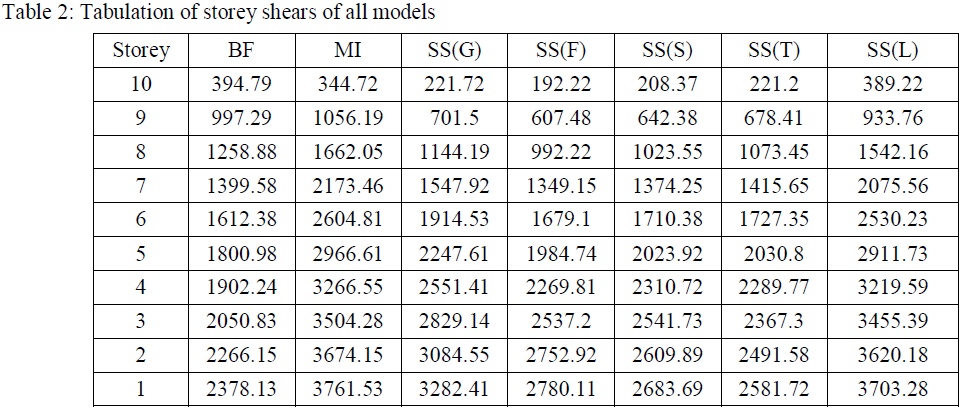 |
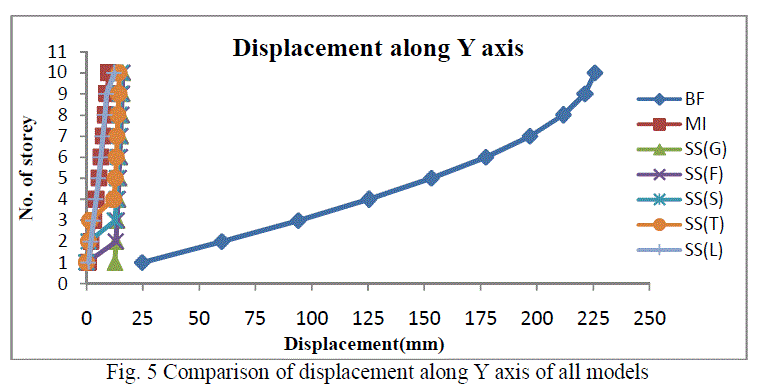 |
| Storey shear is the distribution of design base shear along height of the structure. The storey shear is more for RC frame with masonry infill, soft storey and least for bare frame (BF). Storey shear depends on stiffness in the frame. The struts resist the lateral seismic forces through axial compression along the strut. The contribution of infill increases the stiffness of the frame this resulting increase in seismic forces than the BF. From Fig.3 shows that MI have maximum value of storey shear than BF and SS models. |
3. Displacement |
| The introduction of infill wall in the RC frame reduces the lateral displacement. The displacement is depending on stiffness of the structure. |
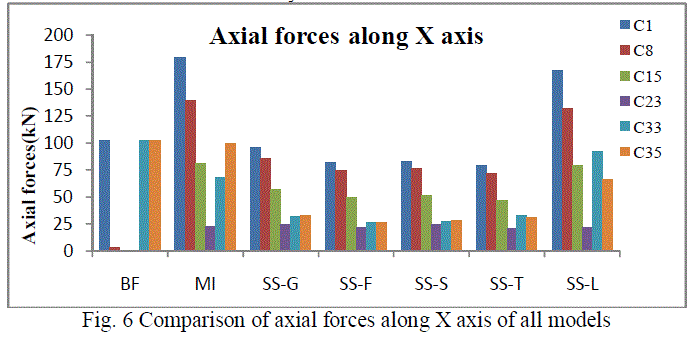 |
| The BF had maximum displacement in both the axis while in MI have least displacement. Displacement in SS is more than MI and lowers than BF model. The displacement in the structure depends on location of the soft storey. In both axis X and Y the displacement is more in BF than MI and SS as shown in Fig.4 and Fig.5. |
4. Axial forces |
| The infill increases the axial forces in columns. Storey 6 has been chosen. For the location of columns refer Fig.1. |
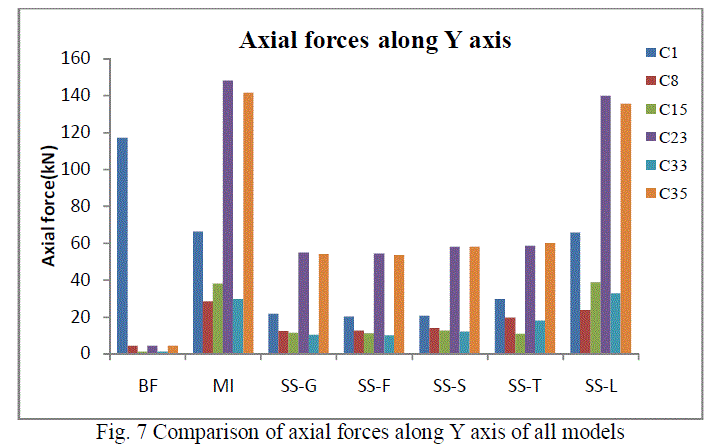 |
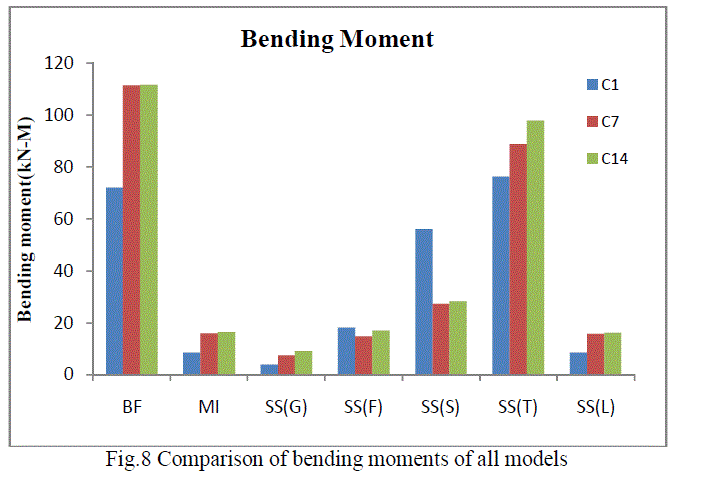 |
| Due to presence of infill the stiffness also increases in frame with increase of axial forces in column. The BF has minimum value of axial forces in columns compared to MI and SS in both the axis as shown in Fig.6 and Fig.7. From Fig. 6 the outer columns having more axial forces than inner column and from Fig. 7 the inner column receives more axial forces in column than outer column. |
5. Column forces |
| The load transfer mechanism is changed from frame action to predominant truss action leads to reduce of bending moment and shear force in columns. Storey 4 has been chosen. For the location of columns refer Fig.1 |
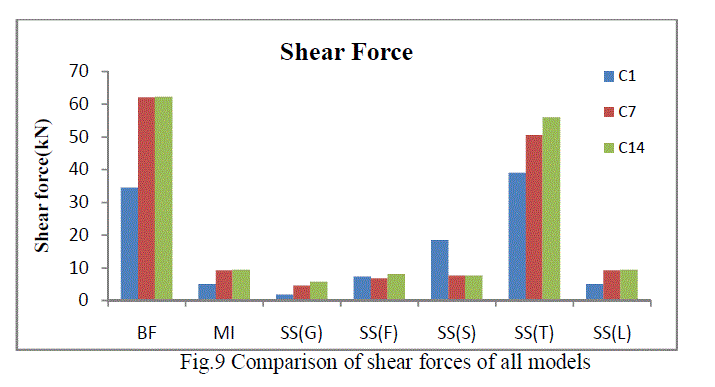 |
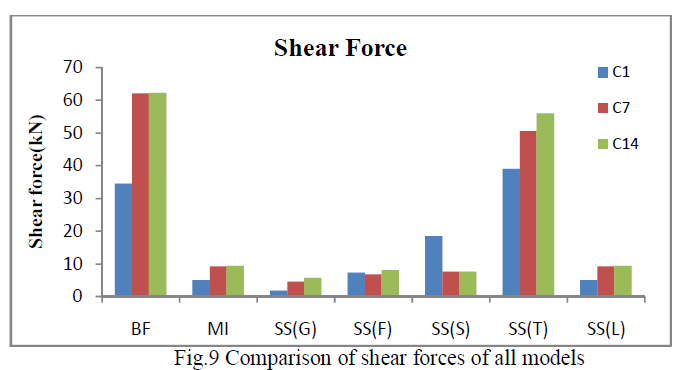 |
| In the above Fig.8 and Fig.9, the bending moments and shear forces of the column in BF is more. Infill increases stiffness in the frame due to this bending moments and shear forces in columns is less in MI and SS models compared to BF. The MI and SS models have low value of bending moment and shear force because due to presence of infill. In all SS models the SS(T) had highest value and SS(G) had least value of bending moment and shear forces. |
VII. CONCLUSIONS |
| 1. Increase in stiffness the time period is decrease. The RC frame with BF having highest value of period compared to masonry infill without soft storey(MI) and masonry infill with soft storey(SS). |
| 2. Infill wall reduces 88.11% and 85.46% of bending moment and shear forces in frame respectively and decreasing probability of collapse. |
| 3. The performance of masonry infill without soft storey(MI) was significantly better to that of BF and masonry infill with soft storey(SS) models. |
| 3. The top displacement of masonry infill without soft storey(MI) is 94-95.6% and masonry infill with soft storey(SS) have 92-93.5% less compare to bare frame(BF). |
| 4. RC frame with masonry infill without soft storey(MI) and masonry infill with soft storey(SS) is having highest value of storey shear than bare frame(BF). |
| 5. The axial forces in MI and SS models are high due to presence of infill leads to stiffness in the frame. |
| 6. The bending moment and shear force are minimum in masonry infill without soft storey(MI) and masonry infill with soft storey(SS) and it is maximum in bare frame(BF). |
| 7. Infill walls increase the strength, stiffness and energy dissipation capacity of the frame. |
| 8. The BF have minimum in storey shear, axial forces and maximum in displacement, time period. |
References |
|